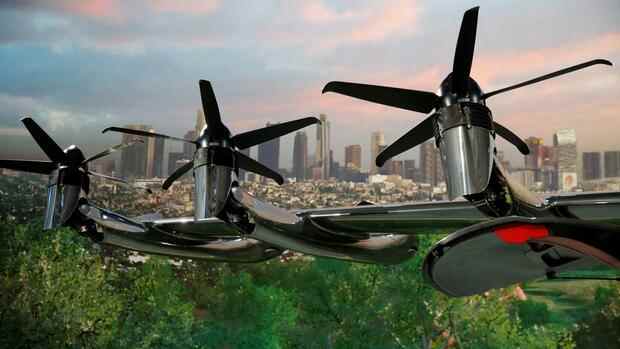The Lufthansa partner United Airlines has taken a stake in the US start-up and intends to use the electric vertical take-off aircraft for part of the future traffic.
(Photo: Reuters)
new York It is a clear requirement from Washington: the government wants the US economy to be ecologically restructured, in line with the Paris climate agreement. The USA rejoined under President Joe Biden in 2021 after predecessor Donald Trump had caused the exit.
Now the White House is stepping up the pace, including in aviation. According to Biden’s “Build Back Better” program, all flights are to be operated with non-fossil, environmentally friendly fuel, known as SAF, by 2050. One basis for this sustainable kerosene is waste. According to calculations by the US Department of Energy, the annual forest and agricultural waste is enough to produce 17 billion gallons – around 64 billion liters – of SAF. That would cover about three quarters of today’s US kerosene needs.
If the White House has its way, the transition will start moderately: First, the US aviation industry is to use three billion tons of SAF per year to reduce its emissions by 20 percent by 2030. That should be expensive, because SAF costs significantly more than kerosene. Nevertheless, Scott Kirby, head of the big line United Airlines, believes that it can be shouldered. “Ticket prices should be a little higher to offset the environmental impact,” he argued at a recent panel discussion.
>>> Read here: Synthetic kerosene – the beacon of hope above the clouds
Top jobs of the day
Find the best jobs now and
be notified by email.
United Airlines wants to fly CO2-neutral by 2050 – without beautifying its own balance sheet with CO2 compensation programs. The airline has pledged to purchase 1.6 billion gallons of SAF. That may sound ambitious at first: Before the Covid crisis, United burned around four billion gallons of kerosene in a normal fiscal year. Only a million gallons was SAF. So there is still a long way to go to become a green airline.
Nevertheless, they proudly refer to their own future projects. In December, for example, United operated the first flight with 115 passengers from Chicago to Washington with one engine powered 100 percent by SAF. Competitor American Airlines initiated a working group in October with nine other major airlines, including Cathay Pacific and Southwest. This is advised by Boston Consulting and is intended to pool money to accelerate the development of environmentally friendly fuels. The US company Delta Air Lines recently joined a similar initiative called the “First Movers Coalition”, to which the US State Department belongs, for example.
United Airlines bought into the air taxi company Archer
The US airlines United and JetBlue are already adding a small amount of biofuel to flights departing from California. Last September, JetBlue said it was well on the way to covering 10 percent of its kerosene needs with SAF by 2030. The competition from Delta also wants to use ten percent sustainable fuels by 2030 and is working with the oil company Chevron on the use of SAF. However, Delta left a back door open in the announcement: The plans are “subject to availability and feasibility”.
In addition, some airlines are relying on new aviation concepts. For example, United has invested in the air taxi company Archer, which promises green mobility using electric drives. The step is more consistent than that of Lufthansa, which has entered into a partnership with the air taxi company Lilium, but is reluctant to invest.
Not all US airlines have invested in the same way, but many have already ordered the high-flyers, which have so far only taken off in test operations. American Airlines ordered 350 aircraft from Vertical Aerospace, United Airlines ordered 200 aircraft from Archer. Competitors Republic Airways and SkyWest have placed a total of 300 orders with Embraer/Eve. However, no one in the industry expects approval before the end of 2023.
In addition, the contribution of air taxis to the sustainable restructuring of aviation will be limited. More than 50 percent of global take-offs involve flights less than 1,111 kilometers in length. However, these account for only one percent of the routes flown. The long haul – that is the main problem.
In the long term, a completely new design for commercial aircraft could help here. Boeing is working on this with NASA, among others. New approaches include hydrogen engines, smaller turbine cores and new wing shapes vaguely reminiscent of the biplanes from the early days of flight (so-called “transonic truss-braced wings”).
More: More expensive tickets and the threat of job loss: Aviation sharply criticizes the EU climate package.

